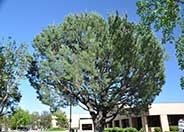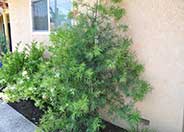
Common name:Italian Stone Pine
Botanical name:Pinus pinea
Italian Stone Pine (Pinus pinea) is a large pine tree with a moderate growth rate, reaching up to 40’-80' tall and 40’-60' wide. This tree should not be selected for small to medium-sized gardens as it will outgrow the space very quickly. It is also not recommended for fire-prone areas. Visit the Orange County Fire Authority for more information. It is unparticular about its soil, and it is considered a low-water-use tree. The needles of this pine tree are quite long, and the tree can be messy, so it is best to plant this tree without any under-planting, using natural wood mulch underneath. Needle droppings can be left in place under the tree, adding to the natural mulch. There is very little pruning or care this tree needs when it is small, but once it has been in place for a few years, the pruning should be left to a licensed arborist to keep the tree looking and performing at its best. This tree should be planted at least 10 feet away from any hardscape areas, 30 feet from structures such as houses and buildings, and not near any powerlines. Shrubs and perennials should be planted about 5 feet away from this tree. It should be irrigated for about

Common name:California Sycamore
Botanical name:Platanus racemosa
The California Sycamore is a fast growing deciduous tree that reaches up to 40'-50' high. It tolerates heat, smog, and drought conditions as well as moist conditions; it is native to riparian areas. It has interesting mottled bark when the tree is bare in winter.

Common name:Fern Pine
Botanical name:Afrocarpus gracilior
Soft, narrow, pointed leaves on graceful arching branches characterize this plant. The foliage is gray green, and the plant can be used as an individual specimen, screen, or even a small tree.
Photographer: GardenSoft
Maintain a two to four inch layer of mulch on the soil surface to reduce weeds, infiltrate rain water, and reduce compaction.
Mulching and adding compost to soil can minimize evaporation and help soil absorb and store water.
Remove irrigation water and fertilizer from areas where you don't want weeds to grow.